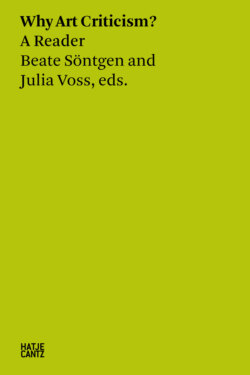Читать книгу Why Art Criticism? A Reader - Группа авторов - Страница 7
ОглавлениеStudies on art criticism’s history and definition—on its protagonists, its significance, its death or at the least its frequently diagnosed crisis—are many and manifold. But few books have gathered the actual raw materials: the critiques themselves, which, after all, are what make the concept of art criticism tangible, lending it concrete form and vitality. This reader thus gives such form to the phenomenon of art criticism via critical exercises and practices. Forty-six voices of art criticism are collected here from across four centuries. The gathered texts have appeared in both analogue and digital form: in newspapers, magazines, journals, and blogs; in popular media, catalogues, and academic publications. From the outset, we wish to avoid any misunderstanding: this reader may begin with the eighteenth century and be arranged in chronological order, but our aim is not to narrate a history or genealogy of art criticism on the basis of particular examples. We are rather seeking to provide a taxonomic account of the variety of art criticism’s forms and roles.
From our perspective, the need for a reader of this sort is clear for two reasons. First, art criticism is often discussed in the singular, but it is historically and presently as varied as art itself. Only by setting out the many and manifold roles and forms, styles, modes of writing, genres, and the diversity of its criteria and domains to which it lays claim is it possible to arrive at a more precise notion and definition of art criticism. Second, and from an entirely pragmatic perspective, the reader offers material for examination and analysis in art-historical pedagogy, and as a suggestion or even possible model of contemporary and future forms of art-critical writing.
Soon after we decided to compile a reader several years ago, it became clear that it could only become reality as a collaborative project, undertaken with other experts. The present reader is thus based on an international workshop—Cultures of Critique: Forms, Media, Effects, held at Leuphana University Lüneburg in 2019, to which we invited specialists from various geographical and intellectual backgrounds to offer brief commentaries on the art critics of their choice. They explained why the chosen texts are important to them, what the texts stood for at the time of their writing, and what they stand for now. The approaches taken to the various critical positions are therefore personal ones, as the brief introductions to the source texts in this book show. To avoid resorting to texts already rendered into English and canonized, we chose to commission a number of new translations. While the publication has brought further art-critical positions into play, we do not seek to provide a systematic index or even a complete overview. Based on the contributors’ suggestions, our book encourages readers to engage with points at which art critics of various provenance intersect, and also where they differ from one another. We ask readers delve into texts from eighteenth-century Paris; nineteenth-century London and Dresden; the twentieth century’s New York, Buenos Aires, Delhi, Moscow, East Berlin, and Beirut; and the Kinshasa, Nairobi, and Tokyo of the twenty-first. Please also note that while all commentaries consistently use American English, in the source essays we have chosen to retain idiosyncrasies regarding translations, academic citation formats, punctuation, and regional forms of English, all of which underscore the sources’ heterogeneity.
Our profuse thanks are due to all the authors collected in this volume for their contributions, both for the art critics they have selected and for the illuminating commentaries they have written. We would also like to thank our publisher, Hatje Cantz, for their keenness to include the reader in their program, and Lena Kiessler for her outstanding support in putting together the volume. Kimberly Bradley has been an inspiring and thoughtful editor. The reliable hands of Catharina Berents held together the many threads of this intricate and complex undertaking. We owe much gratitude to the translators Angela Anderson, Brian Richard Bergstrom, Ralph de Rijke, Tiziana Laudato, Stuart L. A. Moss, Francis Riddle, Matthew James Scown, Bela Shayevich, and Katherine Vanovitch, and to book designer Neil Holt, picture editor Jennifer Bressler, and production manager Vinzenz Geppert. For their support, we would like to thank the student research assistants of Leuphana University’s Research Training Group—Jette Berend, Marie Lynn Jessen, David Mielecke, and Katharina Tchelidze—and the group’s office manager, Stephanie Braune. Finally, particular thanks are due to the German Research Foundation for its generous financial support.
Beate Söntgen and Julia Voss
Lüneburg, August 2021
